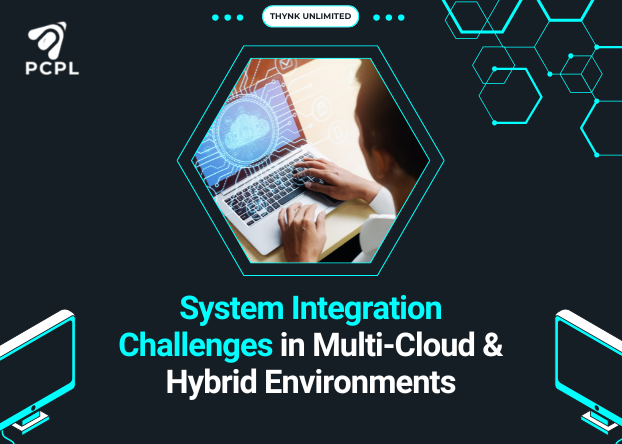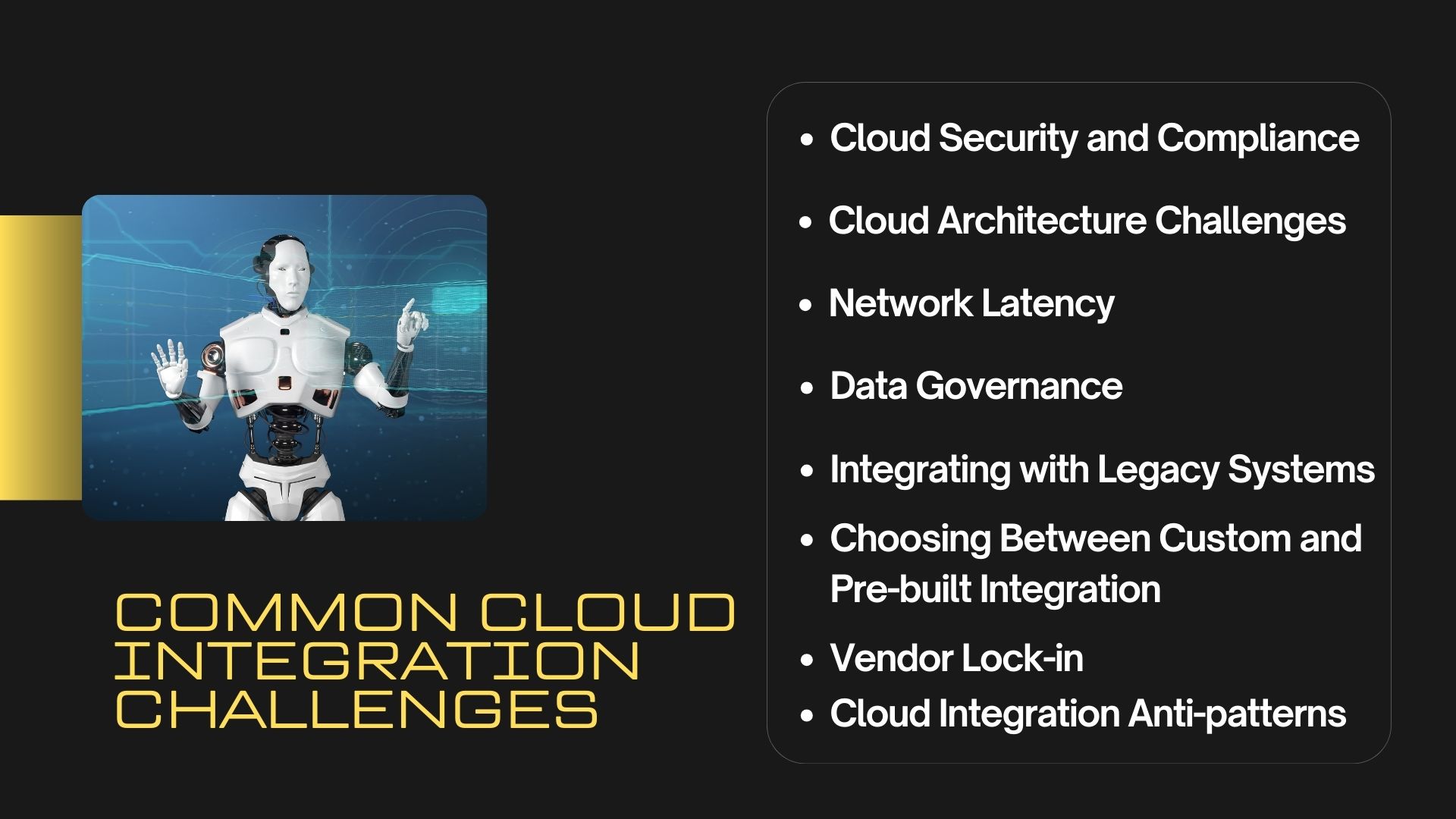
System Integration Challenges in Multi-Cloud & Hybrid Environments
Cloud computing is an essential technology across a number of industries. Many companies are moving important business processes to hybrid cloud environments and services.
Recent statistics show that over 60% of all corporate data is now in the cloud, and about 75% of businesses are prioritizing the development of cloud applications. This shift means that organizations need a way to sync and share data across multiple cloud environments and applications, making an integration solution essential. However, connecting different business applications can be difficult without a strategic approach. It’s important for businesses to be aware of the common challenges that come with cloud integration.
Cloud Integration
Cloud integration is the process of connecting various applications, data, and services hosted in different cloud environments. This can be done between cloud-only applications or as a hybrid integration between cloud and on-premises systems. The goal is to enable smooth communication and data sharing between these different systems and resources. This allows businesses to operate more efficiently, make better decisions, and improve the user experience.
Many tools and platforms are available to help with this process. These tools typically offer connectors, adapters, and APIs to help businesses link, transform, and manage data and applications across both cloud and on-premises environments. With the rise of many integration platforms in recent years, it’s important to carefully evaluate your options before choosing the right one for your needs.
Common Cloud Integration Challenges
Listed below are the most common challenges businesses often face, whether they are using private, public, hybrid, or multi-cloud environments.

1. Cloud Security and Compliance
Data security and compliance are among the top concerns for cloud computing and integration. Sensitive data, like customer information or proprietary business data, can be a prime target for cybercriminals. Larger businesses are especially at risk because they often use multiple cloud solutions, which can create more opportunities for security breaches.
Further, businesses must comply with regulatory standards and security protocols that vary by industry and location. Ensuring data privacy and following regulations like GDPR and HIPAA can be a daunting task. Failing to maintain strong security and compliance can lead to catastrophic data leaks, causing significant reputational and financial damage.
To overcome these challenges, organizations should have a solid data encryption plan and conduct a thorough risk assessment. Implement strong Identity and Access Management (IAM) practices, including role-based access control (RBAC), multi-factor authentication (MFA), and robust password policies. Use strong encryption for data both in transit and at rest, and employ secure data transfer protocols. Regularly audit and update security measures to keep up with evolving threats and changing regulations. Providing security training for employees is also crucial, as many cyberattacks target staff through social engineering.
2. Cloud Architecture Challenges
The unique architecture of cloud systems can be a major integration challenge. Cloud architecture involves the design, structure, and connections of various components within public and private clouds. These complexities can lead to integration problems.
Organizations often use multiple cloud service providers, each with its own unique architecture. For example, Amazon Web Services (AWS), Microsoft Azure, and Google Cloud Platform all have distinct architectures. Integrating data and applications across these platforms can be complex because they may use different protocols and data storage formats.
You should adopt a hybrid cloud integration approach to bridge the gap between different architectures. Using middleware solutions like an Enterprise Service Bus (ESB) or an Integration Platform as a Service (iPaaS) can help facilitate communication between cloud and on-premises systems. Consider using microservices and API gateways to standardize communication between different cloud environments, which can help streamline interactions and improve scalability.
3. Network Latency
Network latency, the delay in data transmission, can seriously impact the speed and efficiency of data transfer during cloud integration. This can lead to slow integration processes and long execution times for workflows. In real-time data-sharing scenarios, like financial transactions, even a small delay can disrupt user experiences and result in lost opportunities.
You need to mitigate network latency by using Content Delivery Networks (CDNs) to cache data and serve it from geographically distributed locations. Edge computing can also help by processing data closer to its source, further reducing latency. For frequently accessed data, using distributed caching can ensure faster retrieval and lessen the impact of network latency.
4. Data Governance
Data governance is a multi-faceted challenge in cloud integration. When businesses exchange large volumes of data between various cloud applications and services, maintaining data accuracy and consistency can be very difficult. Inconsistent data formats, missing values, and duplicate records can all compromise data quality. For example, if a business integrates customer data from multiple platforms, conflicting information may arise, leading to inaccurate customer profiles and potential financial losses.
The way out is to implement data quality checks at every stage of the integration process, including validation for accuracy, consistency, and completeness. Establish a data governance framework that includes data lineage, audit trails, and metadata management. Regular data validation and cleansing processes should be used to ensure data integrity.
- Integrating with Legacy Systems
Legacy systems are older, often outdated, software and hardware that organizations have been using for years. While many businesses still rely on these systems, integrating them with modern cloud solutions can be challenging. Legacy systems often lack or have limited APIs, which makes it difficult for them to communicate seamlessly with cloud applications.
It would be wise to use middleware and data transformation tools to act as intermediaries, translating data between legacy systems and modern cloud applications. A phased integration approach can also be practical, gradually migrating functions from legacy systems to cloud-based alternatives over time to minimize disruptions.
5. Choosing Between Custom and Pre-built Integration
Deciding between building a custom integration solution or using a pre-built one is a significant challenge. Custom integrations are tailored to specific business needs but can be time-consuming, resource-intensive, and difficult to maintain. Pre-built integrations, on the other hand, offer faster deployment with less effort but may not fully meet unique business requirements.
A hybrid approach is often the best solution. Use pre-built integrations for common functions that don’t need extensive customization, and opt for custom integrations only for specific, complex processes. This allows for faster deployment of simple workflows while saving custom development for critical operations.
6. Vendor Lock-in
Over-relying on a single cloud provider can lead to vendor lock-in, where an organization becomes dependent on one provider’s ecosystem. This can limit flexibility and make it difficult to migrate to other platforms. Cloud providers often use proprietary tools and services that are not easily transferable. Migrating away from a provider can be expensive and time-consuming, especially if you need to rearchitect applications and pay for data transfer costs.
To avoid vendor lock-in, prioritize multi-cloud environments, which allows you to distribute workloads across different platforms. Regularly assess the cloud landscape to stay informed about new technologies and provider offerings. Design integrations to be vendor-agnostic whenever possible by using open standards and APIs that are not tied to a single cloud provider.
7. Cloud Integration Anti-patterns
Cloud integration anti-patterns are common mistakes or pitfalls that organizations may fall into. These can lead to inefficiencies, higher costs, and security risks. These are-
- Overcomplicating solutions with too much customization.
- Building large, inflexible, monolithic integrations.
- Failing to use a reputable iPaaS for streamlined integrations.
- Not implementing proper monitoring and logging to identify and resolve issues.
You can address these anti-patterns by adopting agile methodologies for integration projects. Use a user-friendly iPaaS platform and work with integration experts who can help detect and prevent these common mistakes.
Best Practices to Overcome Cloud Integration Challenges
In spite of the challenges, a cloud integration project is important for many organizations, especially large enterprises. To ensure a seamless and secure connection between various cloud services, follow these best practices-
- Understand exactly what data and processes need to be integrated and why.
- Make sure your integration architecture can handle future growth and increased workloads.
- Implement strong security measures to protect data and comply with all relevant regulations.
- Ensure that data formats are compatible and that any necessary data transformation is done accurately.
- Have a plan to promptly catch and address integration issues.
- Always test integrations in a staging environment before deploying them to production.
- Keep detailed documentation for all integrations to make troubleshooting easier.
- Encourage teamwork between IT teams, business units, and cloud service providers.
The most important step is to work with a reliable cloud data integration platform that provides pre-built connectors and can also handle custom integrations. A high-performing iPaaS can help enterprises overcome many of these challenges by efficiently connecting both cloud and on-premises applications.
Conclusion
From security and compliance to architectural complexities, network latency, and the choice between custom and pre-built solutions, we’ve covered many of the cloud integration challenges that businesses face. We’ve also provided solutions and best practices to help you deal with them. Once you understand these obstacles and follow a strategic approach, you can turn these challenges into opportunities for building a more connected and successful future for your business.
References
https://www.nutanix.com/info/multi-cloud-environment
https://www.appseconnect.com/8-cloud-integration-challenges-and-overcoming-them/
